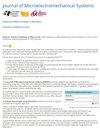Lateral Glow Discharge Ion Source for the Integrated MEMS Quadrupole Mass Spectrometer
IF 3.1
3区 工程技术
Q2 ENGINEERING, ELECTRICAL & ELECTRONIC
引用次数: 0
Abstract
This article presents a glow discharge ion source specifically designed for integration into a fully MEMS-based quadrupole mass spectrometer. The main challenge was to develop an ion source in the form of a multi-layer structure capable of extracting an ion beam in lateral direction and directing it toward the analyzer. Throughout the study, several test structures with varying degrees of complexity were proposed and tested. As anticipated, a trade-off was observed, where successive simplifications of the structure’s geometry led to a reduced operating pressure range and lower emitted ion currents. The structure that proved to be the most technologically compatible with the proposed mass spectrometer demonstrated sufficient efficiency, operating in medium vacuum range (from集成MEMS四极杆质谱仪的侧向辉光放电离子源
本文介绍了一个辉光放电离子源,专门设计集成到一个完全基于mems的四极杆质谱仪。主要的挑战是开发一种多层结构形式的离子源,能够在横向方向提取离子束并将其导向分析仪。在整个研究过程中,提出并测试了几种不同复杂程度的测试结构。正如预期的那样,观察到一种权衡,即结构几何形状的连续简化导致操作压力范围减小和发射离子电流降低。该结构被证明在技术上与所提出的质谱仪最兼容,证明了足够的效率,工作在中真空范围(从$2\乘以10^{-3}$ hPa)到高真空范围($1\乘以10^{-5}$ hPa),提取的离子电流达到数十$\mu $ a。[2024-0140]
本文章由计算机程序翻译,如有差异,请以英文原文为准。
求助全文
约1分钟内获得全文
求助全文
来源期刊

Journal of Microelectromechanical Systems
工程技术-工程:电子与电气
CiteScore
6.20
自引率
7.40%
发文量
115
审稿时长
7.5 months
期刊介绍:
The topics of interest include, but are not limited to: devices ranging in size from microns to millimeters, IC-compatible fabrication techniques, other fabrication techniques, measurement of micro phenomena, theoretical results, new materials and designs, micro actuators, micro robots, micro batteries, bearings, wear, reliability, electrical interconnections, micro telemanipulation, and standards appropriate to MEMS. Application examples and application oriented devices in fluidics, optics, bio-medical engineering, etc., are also of central interest.
 求助内容:
求助内容: 应助结果提醒方式:
应助结果提醒方式:


